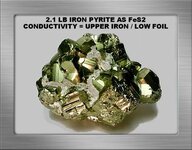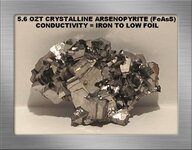Jim Hemmingway
Hero Member
- Jan 26, 2008
- 789
- 1,617
- Detector(s) used
- F-75, Infinium LS, MXT, GoldBug2, TDI Pro, 1280X Aquanaut, Garrett ProPointer
- Primary Interest:
- Prospecting
Hi Everyone,
I've read literature by well-known detector-prospectors, and completed a TreasureNet search on this topic. Such pretty much indicates that tellurides, for example calaverite or sylvanite... there are others too... are not detectable. But, there have been recent posts here and elsewhere that suggest tellurides are detectable.
How about posting your experience or thoughts on this subject for me. I'd certainly appreciate any helpful ideas or suggestions you could share with me. I have no sample to test, but needless to say I don't mean tellurides that obviously show native gold or silver on their surface. Thankyou, looking forward to your replies.
Jim.
I've read literature by well-known detector-prospectors, and completed a TreasureNet search on this topic. Such pretty much indicates that tellurides, for example calaverite or sylvanite... there are others too... are not detectable. But, there have been recent posts here and elsewhere that suggest tellurides are detectable.
How about posting your experience or thoughts on this subject for me. I'd certainly appreciate any helpful ideas or suggestions you could share with me. I have no sample to test, but needless to say I don't mean tellurides that obviously show native gold or silver on their surface. Thankyou, looking forward to your replies.

Jim.
Amazon Forum Fav 👍
Upvote
0





